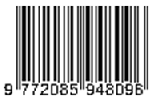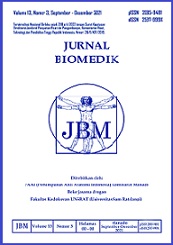Perbandingan efektivitas asam perasetik dan feracrylum pada pola kuman ulkus diabetik
DOI:
https://doi.org/10.35790/jbm.8.1.2016.12335Abstract
Abstract: Diabetic ulcer is a condition of infection, ulceration, and or destruction of inner skin tissue related to neurological disorders and degrees of peripheral arterial disease (PAD) in diabetic patients. Diabetic ulcer is prone to infection due to decreased immune response, therefore, opportunistic microbes can become pathogens. Infection is sttill a serious problem in diabetic ulcer since the high cost and long duration of treatment lead to complicated neclected ulcer. This study aimed to obtain the present profile of microbes in diabetic ulcers and the effectivitveness of peracetic acid dan feracrylum in the treatment of diabetic ulcers. This was a descriptive analytical study. The ulcer degree was determined by using PEDIS criteria. Pus specimen was taken with a sterile technique using a transport media, cultured in the Baxtec machine, and the microbes were identified and further tested for sensitivity to peracetic acid dan feracrylum 1%. The results showed that of the 57 patients there were 36 females with a mean age of 58.77+ 9.077 years. Most of the patients (30 patients) had diabetic ulcers of 4th degree. The result of pus culture showed Gram negative Proteus mirabilis as the most frequent microbe (17.5%). The sensitivity test showed that 100% of 12 types of microbes, 83.3% of Citrobacter diversus, and 60% of Proteus mirabilis samples were sensitive to peracetic acid, meanwhile, all microbes were resistant to feracrylum 1% dan NaCl as controls,. Conclusion: Peracetic acid was more effective than feracrylum 1% as topical antimicrobial for diabetic ulcer.
Keywords: diabetic ulcer, microbe, topical antimicrobial agent
Abstrak: Ulkus diabetik adalah suatu kondisi adanya infeksi, ulserasi dan atau kerusakan jaringan kulit yang lebih dalam yang berhubungan dengan kelainan neurologik serta berbagai tingkatan peripheral arterial disease (PAD) pada penderita diabetes melitus (DM). Ulkus diabetik lebih mudah terinfeksi karena respons kekebalan tubuh penderita DM biasanya menurun, bahkan kuman oportunistik juga dapat menjadi patogen. Infeksi masih menjadi masalah yang paling serius dialami penderita ulkus diabetik oleh karena biaya pengobatan yang besar dan waktu perawatan yang lama sehingga ulkus sering dibiarkan terinfeksi dengan komplikasi tanpa perawatan adekuat. Penelitian ini bertujuan untuk memperoleh data terkini pola kuman penderita ulkus diabetik dan untuk mengetahui efektivitas asam perasetik dan feracrylum pada pola kuman ulkus diabetik. Jenis penelitian ini ialah deskriptif analitik. Derajat ulkus dinilai dengan kriteria PEDIS. Spesimen pus diambil secara steril dengan media transpor, ditanam dalam mesin Baxtec, kemudian dilakukan identifikasi kuman dan uji sensitivitas terhadap asam perasetik dan feracrylum 1%. Hasil penelitian memperlihatkan dari 57 penderita ulkus diabetik terbanyak ialah perempuan (36 penderita) dengan rerata usia 58,77+9,077 tahun. Sebagian besar ulkus diabetik (30 penderita) termasuk derajat 4. Hasil kultur memperlihatkan Proteus mirabilis (Gram negatif) yang tersering (17,5%). Hasil uji sensitivitas pola kuman memperlihatkan 100% sampel dari 12 jenis kuman, 83,3% dari Citrobacter diversus, dan 60% dari Proteus mirabilis sensitif terhadap asam perasetik, sedangkan terhadap feracrylum 1% dan NaCl sebagai kontrol, seluruh kuman telah resisten. Simpulan: Asam perasetik lebih efektif dibandingkan feracrylum 1% sebagai antimikroba topikal pada ulkus diabetik.
Kata kunci: ulkus diabetik, mikroba, antimikroba topikal
Downloads
Issue
Section
License
Penyunting menerima sumbangan tulisan yang BELUM PERNAH diterbitkan dalam media lain. Naskah yang masuk dievaluasi dan disunting keseragaman format istilah dan cara penulisan sesuai dengan format penulisan yang terlampir dalam jurnal ini.
Segala isi dan permasalahan mengenai tulisan yang yang diterbitkan dalam jurnal menjadi tanggung jawab penuh dari penulis.







